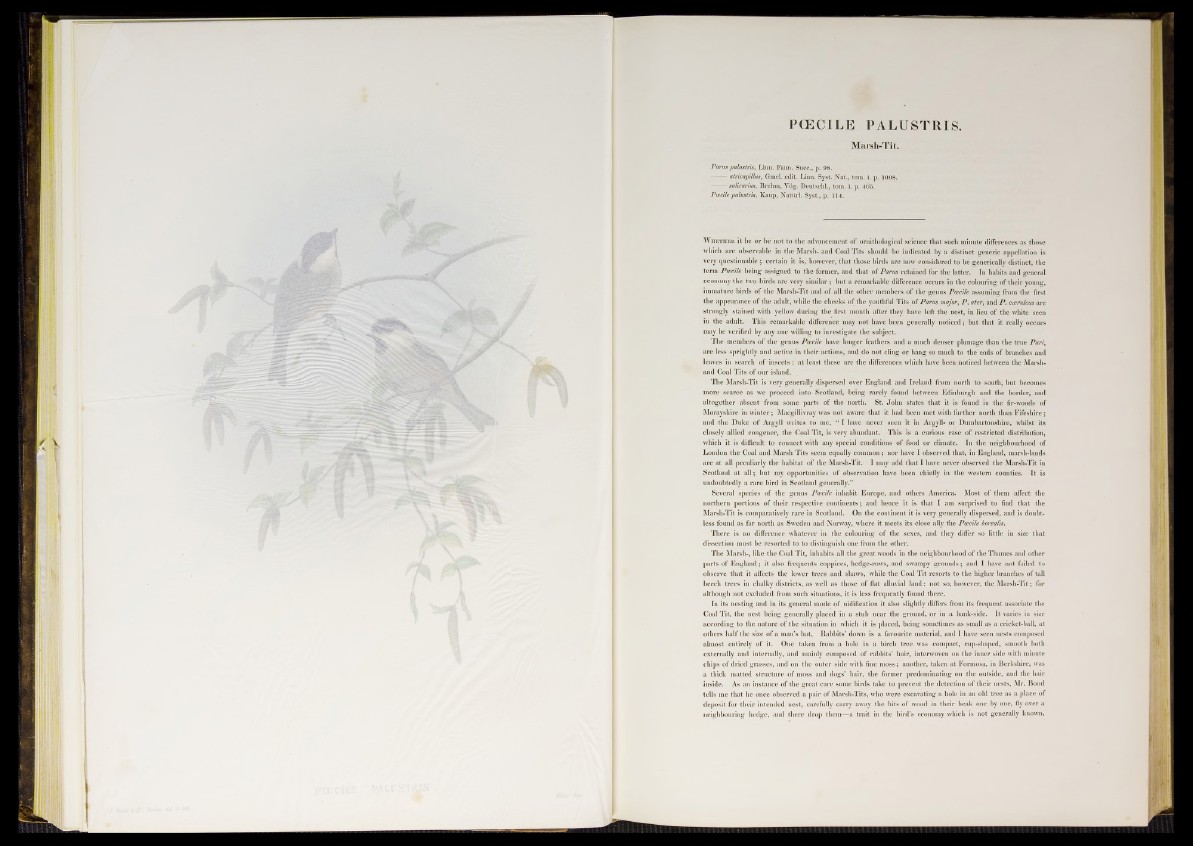
/ V
PCECILE PALUSTRIS .
Marsh-Tit.
Pams palustris, Linn. Faun. Suec., p. 98.
— atricapillus, Gmel. edit. Linn. Syst. Nat., tom. i. p. 1008.
— salicarius, Brehm, Vög. Deutschi., tom. i. p. 465.
Piecile palustris, Kaup, Natiirl. Syst., p. 114.
W h e t h e r it be or be not to tbe advancement of ornithological science that such minute differences as those
which are observable in the Marsh- and Coal Tits shoulcb'be indicated by a distinct generic appellation is
very questionable ; certain it is, however, that those birds are now considered to be generically distinct, the
term Poecile being assigned to the former, and that o f Parus retained for the latter. In habits and general
economy the two birds are very similar ; but a remarkable difference occurs in the colouring of their young,
immature birds of the Marsh-Tit and of all the other members of the genus Pcecile assuming from the first
the appearance o f the adult, while the cheeks of the youthful Tits of Parus major, P. ater, and P . caeruleus are
strongly stained with yellow during the first month after they have left the nest, in lieu of the white seen
in tbe adult. This remarkable difference may not have been generally noticed; but that it really occurs
may be verified by any one willing to investigate the subject.
The members o f the genus Poecile have longer feathers and a much denser plumage than tbe true Pari,
are less sprightly and active in their actions, and do not cling or hang so much to the ends of branches and
leaves in search of insects : a t least these are the differences which have been noticed between the Marsh-
and Coal Tits of our island.
The Marsh-Tit is very generally dispersed over England and Ireland from north to south, but becomes
more scarce as we proceed into Scotland, being rarely found between Edinburgh and the border, and
altogether absent from some parts o f the north. St. John states that it is found in the fir-woods of
Morayshire in winter; Macgillivray was not aware that it bad been met with further north than Fifeshire;
and the Duke o f Argyll writes to me, “ I have never seen it in Argyll- or Dumbartonshire, whilst its
closely allied congener, the Coal Tit, is very abundant. This is a curious case of restricted distribution,
which it is difficult to connect with any special conditions o f food or climate. In the neighbourhood of
London the Coal and Marsh Tits seem equally common; nor have I observed that, in England, marsh-lands
are at all peculiarly the habitat of the Marsh-Tit. I may add that I have never observed the Marsh-Tit in
Scotland at a ll; but my opportunities of observation have been chiefly in the western counties. I t is
undoubtedly a rare bird in Scotland generally.”
Several species of the genus Poecile inhabit Europe, and others America. Most of them affect the
northern portions of their respective continents; and hence it is that I am surprised to find that the
Marsh-Tit is comparatively rare in Scotland. On the contiuent it is very generally dispersed, and is doubtless
found as far north as Sweden and Norway, where it meets its close ally the Poecile borealis.
There is no difference whatever in the colouring o f the sexes, and they differ so little in size that
dissection must be resorted to to distinguish one from the other.
The Marsh-, like the Coal Tit, inhabits all the great woods in the neighbourhood o f the Thames and other
parts o f England; it also frequents coppices, hedge-rows, and swampy grounds; and I have not failed to
observe that it affects the lower trees and shaws, while the Coal T it resorts to the higher branches o f tall
beech trees in chalky districts, as well as those of flat alluvial land: not so, however, the Marsh-Tit; for
although not excluded from such situations, it is less frequently found there.
In its nesting and in its general mode of nidification it also slightly differs from its frequent associate the
Coal Tit, the nest being generally placed in a stub near tbe grouud, or in a bank-side. It varies in size
according to the nature o f the situation in which it is placed, being sometimes as small as a cricket-ball, at
others half the size o f a man’s hat. Rabbits’ down is a favourite material, and I have seen nests composed
almost entirely of it. One taken from a hole in a birch tree was compact, cup-shaped, smooth both
externally and internally, and mainly composed of rabbits’ hair, interwoven on the inner side with minute
chips o f dried grasses, and on the outer side with fine moss; another, taken a t Formosa, in Berkshire, was
a thick matted structure of moss and dogs’ hair, tbe former predominating on the outside, and the hair
inside. As an instance of the great care some birds take to prevent the detection of their nests, Mr. Bond
tells me that he once observed a pair of Marsh-Tits, who were excavating a hole in an old tree as a place of
deposit for their intended nest, carefully carry away the bits of wood in their beak one by one, fly over a
neighbouring hedge, and there drop them—a trait in the bird’s economy which is not generally known,